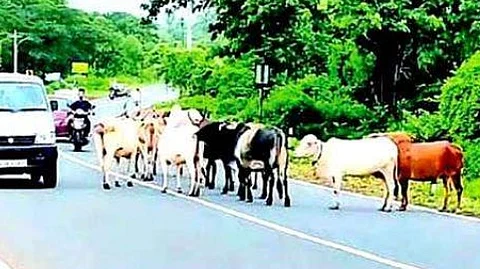

As the Supreme Court of India issues strong directives to the Delhi government on controlling stray dogs in the NCR, Goa is battling a parallel but less-publicised hazard — stray cattle obstructing roads, disrupting traffic and causing fatal accidents. Both issues, rooted in neglect and weak enforcement, reflect a larger governance failure in managing abandoned animals.
Taking a cue from the SC’s orders, the Goa government has formed a three-member task force to address the stray dog menace. But while action on canines has gained urgency, the stray cattle crisis remains unaddressed — despite its visible and daily impact on road safety, particularly for two-wheeler riders.
Animal welfare groups say the situation has worsened as economic and social changes push more owners to abandon cattle. Dhyan Foundation State coordinator Sawati Subhedar explained, “The main reasons why owners are leaving their cattle on roads is because the desi cows have become uneconomical and they do not yield more milk and it is also not nutritious compared to milk of jersey cows which has high nutritional value.
Secondly, children do not want to run their family (dairy farm) business and families have now converted their cow sheds into rooms on rent.”
She said the rapid concretisation of open spaces has left cattle without grazing grounds, driving them onto roads in search of warmth and cleanliness. “In the past, cattle after grazing used to return back before sunset,” she noted. Dhyan Foundation now operates three goshalas in Quepem taluka — at Shirvoi, Zambaulim, and Quitol — sheltering about 1,300 injured and rescued cattle, many of them victims of road mishaps.
Hanumant Parab, President of Jai Shri Cow Sanvardhan Kendra in Valpoi, said owners rarely come forward to reclaim their abandoned cattle. “In a few cases the owner comes but we do not release the cattle if they do not have tags or chips and till the owner convinces us. In addition, the owner has to pay a fine towards the feeder cost as per the Goa Stray Cattle Management Scheme,” he said.
The Valpoi goshala began in 2008 with 14 cattle rescued from an illegal slaughterhouse in Bicholim, later taking in another 114 animals from the State-owned abattoir. Today, most of its residents are seized from municipal areas or brought in after traffic accidents. Parab pointed to a disturbing health hazard — in the last five years, nine cattle had to undergo surgery to remove plastic waste from their stomachs. “This is a major problem. We noticed animals refusing to take feed for many days which could have caused their death,” he said.
Gomantak Gausevak Mahasangh trustee Subhash Parsekar said their shelters now house over 2,700 stray, injured and rescued cattle. “We take care of injured, rescued, and abandoned cattle,” he said, noting that the numbers keep rising